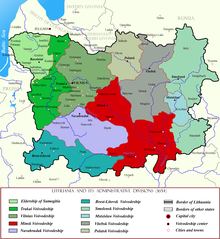
The Ruthenian Voivodeship, also called Rus’ voivodeship, was a voivodeship of the Crown of the Kingdom of Poland from 1434 until the 1772 First Partition of Poland with a center in the city of Lviv. Together with a number of other voivodeships of southern and eastern part of the Kingdom of Poland, it formed Lesser Poland Province, with its capital city in Kraków. Following the Partitions of Poland, most of Ruthenian Voivodeship, except for its northeastern corner, was annexed by the Habsburg monarchy, as part of the province of Galicia. Today, the former Ruthenian Voivodeship is divided between Poland and Ukraine.

Volhynian Voivodeship was a unit of administrative division and local government in the Grand Duchy of Lithuania from 1566 until 1569 and of the Polish Crown within the Polish–Lithuanian Commonwealth from the 1569 Union of Lublin until the Third Partition of Poland in 1795. It was part of the Ruthenian lands in the Lesser Poland Province.

Sandomierz Voivodeship was a unit of administration and local government in Poland from the 14th century to the partitions of Poland in 1772–1795. It was part of the Lesser Poland region and the Lesser Poland Province. Originally Sandomierz Voivodeship also covered the area around Lublin, but in 1474 its three eastern counties were organized into Lublin Voivodeship. In the 16th century, it had 374 parishes, 100 towns and 2586 villages. The voivodeship was based on the Sandomerz ziemia, which earlier was the Duchy of Sandomierz. The Duchy of Sandomierz was created in 1138 by King Bolesław III Wrymouth, who in his testament divided Poland into five principalities. One of them, with the capital at Sandomierz, was assigned to Krzywousty's son, Henry of Sandomierz. Later on, with southern part of the Seniorate Province, the Duchy of Sandomierz created Lesser Poland, divided into Kraków and Sandomierz Voivodeships.

Mstislaw Voivodeship or Mścisław Voivodeship was a unit of administrative division and local government in the Grand Duchy of Lithuania, since the 15th century until the Partitions of Poland in 1795.

Vitebsk Voivodeship was a unit of administrative division and local government in the Grand Duchy of Lithuania from the 15th century until the partitions of Poland in 1795.

Polotsk or Połock Voivodeship was a unit of administrative division and local government in the Polish–Lithuanian Commonwealth since the 15th century until the partitions of Poland in 1793.

Brest Litovsk Voivodeship was a unit of administrative territorial division and a seat of local government (voivode) within the Grand Duchy of Lithuania since 1566 until the May Constitution in 1791, and from 1791 to 1795 as a voivodeship in Poland. It was constituted from Brest-Litovsk and Pinsk counties.

Trakai Voivodeship, Trakai Palatinate, or Troki Voivodeship, was a unit of administrative division and local government in the Grand Duchy of Lithuania from 1413 until 1795.
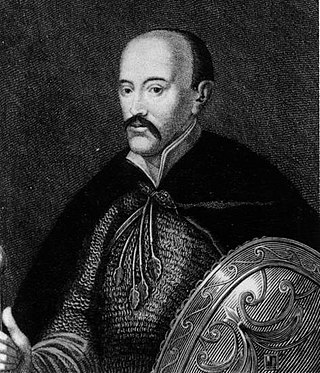
Aleksander Korwin Gosiewskide armis Ślepowron, was a Polish nobleman, military commander and diplomat, Lithuanian Field-Quartermaster since 1630, Palatine-Governor of Smolensk from 1625, Lithuanian Great-Quartermaster since 1615, Speaker of the Parliament in 1613, Great-Secretary of the Grand Duchy of Lithuania from 1610 and District-Governor of Wieliż, Puńsk, Kupise, Biel, and Markowa.
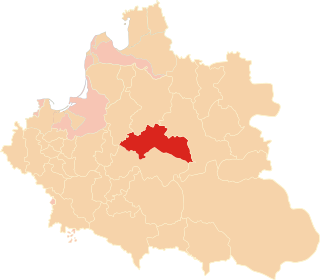
Nowogródek Voivodeship was a voivodeship of the Grand Duchy of Lithuania from 1507 to 1795, with the capital in the town of Nowogródek. Since 1569 it was located in the Polish–Lithuanian Commonwealth, as part of Lithuania.

The House of Sapieha is a Polish-Lithuanian noble and magnate family of Ruthenian origin, descending from the medieval boyars of Smolensk and Polotsk. The family acquired great influence and wealth in the Polish–Lithuanian Commonwealth during the 16th century.

Mikołaj Krzysztof Sapieha of Lis coat of arms, was the Voivode of Nowogródek (1618–38), Voivode of Mińsk (1638–39), Notary of Lithuania since 1637 in the Polish–Lithuanian Commonwealth.
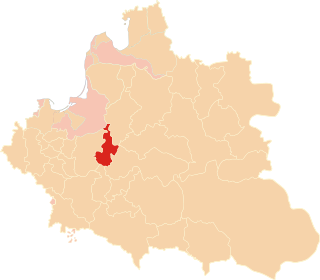
The Podlaskie Voivodeship was formed in 1513 by Sigismund I the Old as a voivodeship in the Grand Duchy of Lithuania, from a split off part of the Trakai Voivodeship. After Lithuania's union with the Kingdom of Poland in 1569 and formation of the Polish–Lithuanian Commonwealth, the voivodeship was transferred to the Polish Crown, where it belonged to the Lesser Poland Province of the Polish Crown.
Mikołaj Sapieha may refer to several nobles from the Sapieha family:

Mikołaj Sapieha (1581–1638) was a voivode in the Polish–Lithuanian Commonwealth.

Mikołaj Sapieha (1581–1644) also known as Pobożny ("Pious") was a nobleman of the Polish–Lithuanian Commonwealth and Great Standard-Keeper of Lithuania. He was also Voivode of Minsk, Voivode of Brześć Litewski and Castellan of Vilnius.

The Kraków Voivodeship was a voivodeship (province) in the Kingdom of Poland from the 14th century to the partition of Poland in 1795. Located in the southwestern corner of the country, it was part of the Lesser Poland region and the Lesser Poland Province.

Lublin Voivodeship was an administrative region of the Kingdom of Poland created in 1474 out of three eastern counties of Sandomierz Voivodeship and lasting until the Partitions of Poland in 1795. Together with Sandomierz Voivodeship and Kraków Voivodeship, it was part of historic Lesser Poland. Lublin Voivodeship had two senators in the Senate of the Kingdom of Poland: the Voivode and the Castellan of Lublin. Local sejmiks took place in Lublin.
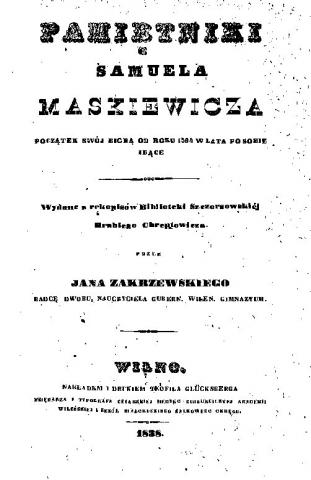
Samuel Maskiewicz was a Polish-Lithuanian officer, Hussar of the Grand Duchy of Lithuania, a participant in the Moscow Campaign, writer–memoirist, author of a diary published in Russia.
